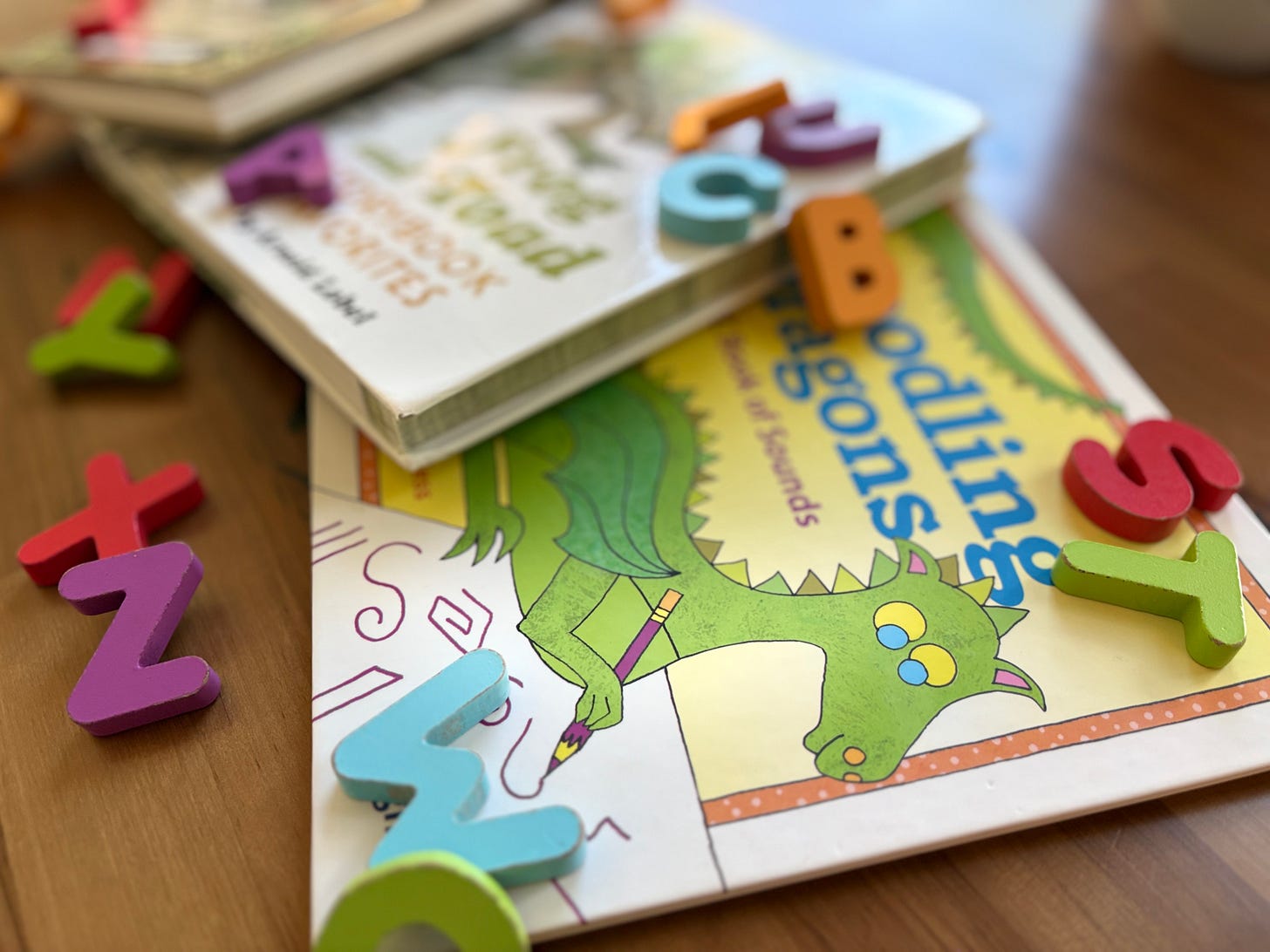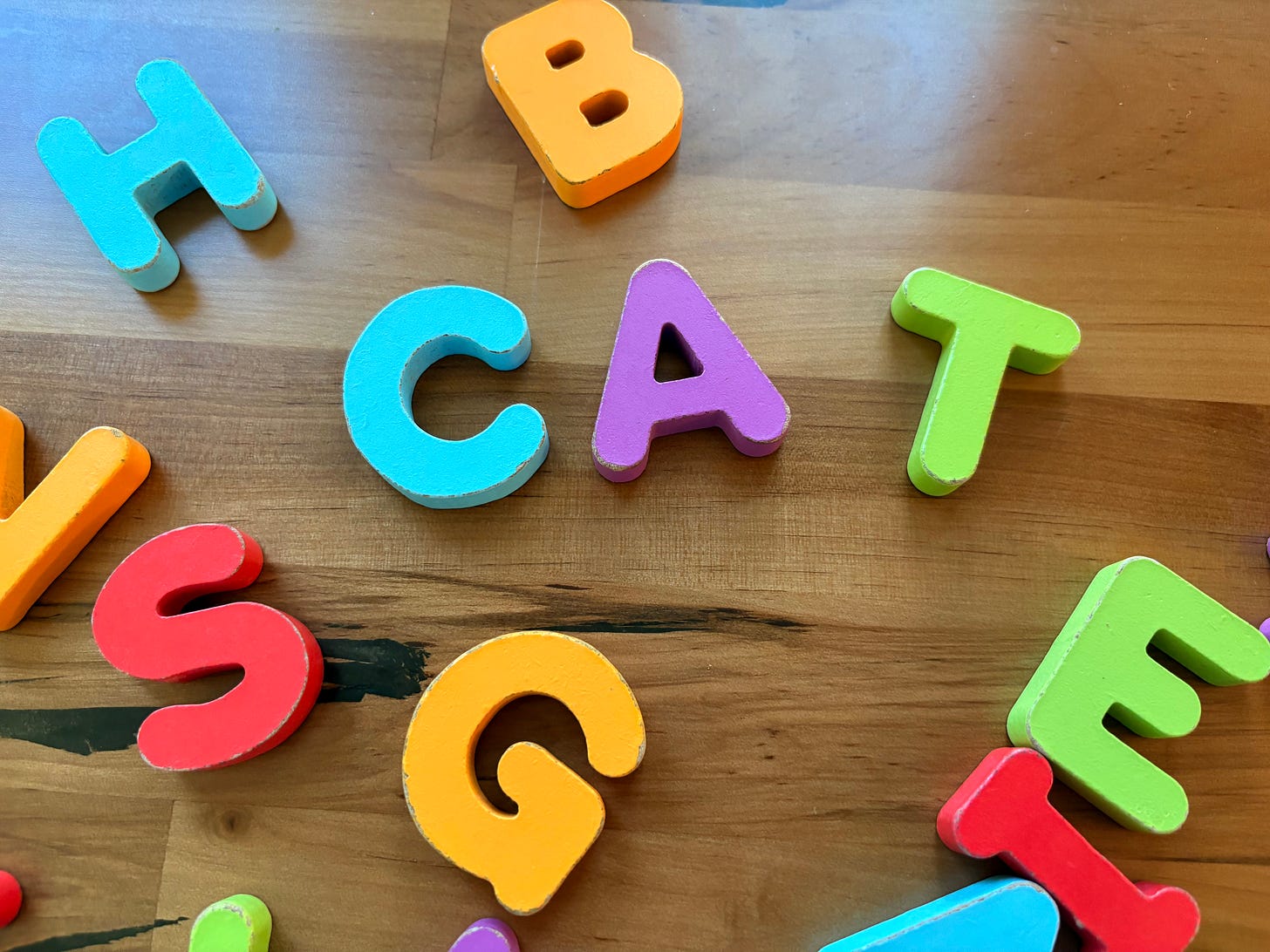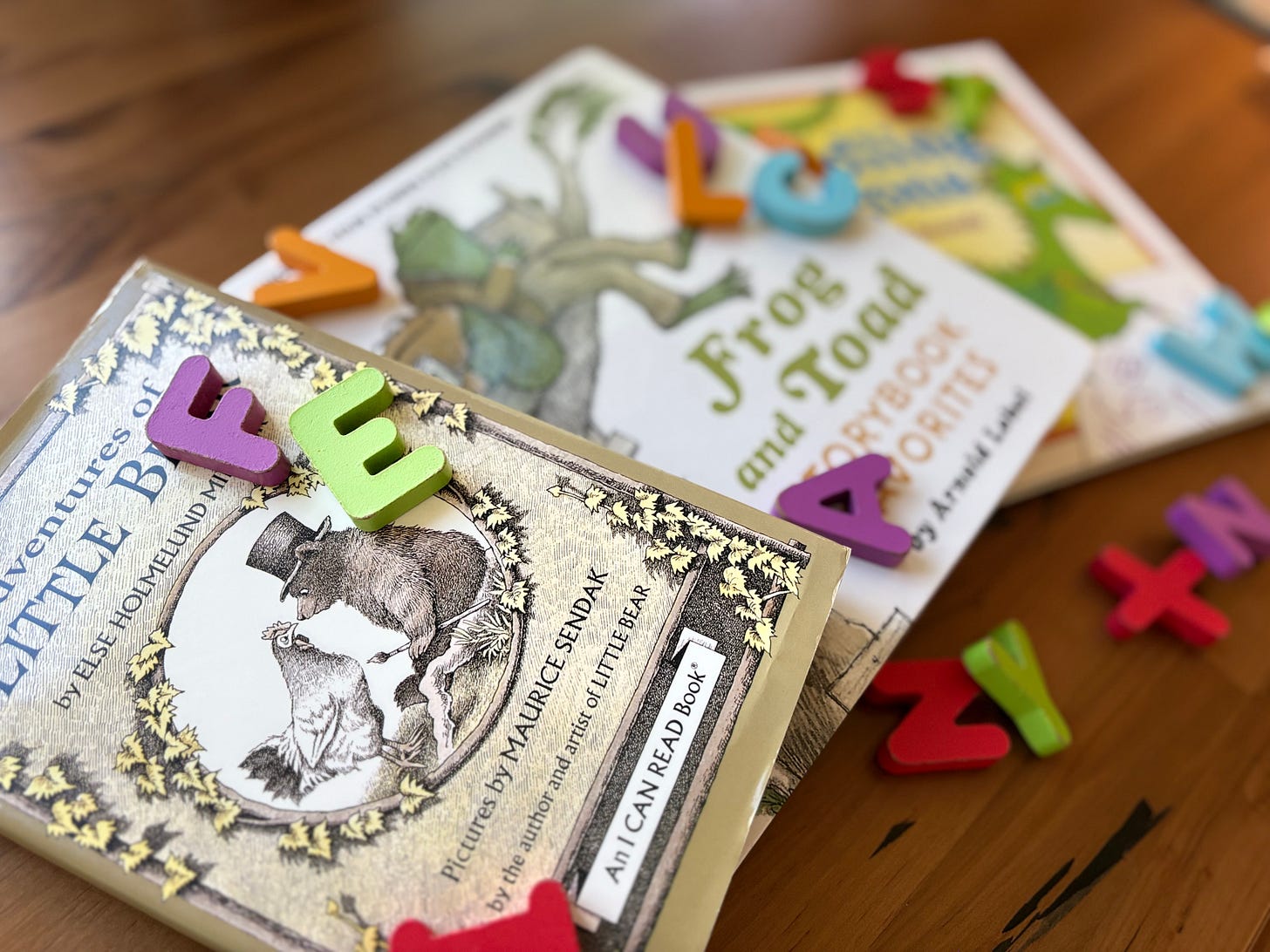When you ask another homeschool mom how they teach their child to read, you’re often going to get the answer, “I used Teach Your Child to Read in 100 Easy Lessons.”
There is nothing wrong with this. In fact, you may have tried this resource before or have reason to praise this program.
However, I’d like to offer you a more living approach to teaching your child how to read.
CONTENTS:
Getting Started: Phonics Lessons
Reading Lessons: Reading Together
Early Readers: Recommendations and Must-Reads
Beyond: Give them good books!
Quick Links to Resources
Free Reading Plan PDF
Getting Started: Phonics Lessons
What if phonics instruction didn’t have to be a white paper with “S-A-M” written on it?
What if, instead, it could be filled with music and song? What if you opened a book and when your child saw the letter A, they began reciting words with A’s phonetic sounds?
What if phonics lessons were actually joyful?
Well, they can be! Here’s how you can breathe life into your phonics lessons.
The Doodling Dragons Book Series
The Doodling Dragons books—there are three total, made by the Logic of English—are amazing resources. And no, in case you’re wondering, these are NOT workbooks.
These are books you can read again and again (which I recommend you do!)
Each page features a phonogram on the left side and illustrations with rhymes on the right side. Those rhymes include the phonetic sounds in words within the phrase.
Look at this page for “B” below and you’ll see what I mean.
How to Use This Resource
(A quick note: I do not use the Logic of English program. You’re welcome to try it, but I haven’t. I do, however, love these books and songs, their phonogram chart, and the book for adult readers.)
You can use Doodling Dragons in one of two ways:
You can point to the letter and say its phonetic sounds aloud. (I highly recommend using Logic of English’s free phonogram audio/video chart to ensure you know each one. Links are at the end of this post.) Then, you can read the rhymes to your child.
You can utilize the free songs that accompany these books, which can be found online for free. The songs use the book’s rhymes and are fun. Your child can sing or simply listen along as they look at each page.
Honestly, I do both of the above!
What To Do
I choose about 4-6 phonograms to focus on at a time, and I read those pages to my child, clearly stating the phonetic sounds, reciting the sing-song rhymes, and pointing out the sound in each rhyme after we’ve read the page.
The next time we sit down with the book, I play the songs and point at the letters on the page when we hear its sounds.
If you spend about 2 days on each group of letters (reading the first day, singing the second day), you can finish the first book in about two weeks.
However, you are not done with the book (and you’ve only just started the series!) Be ready to read through the book a second and third time (or more, if your child needs/wants.)
The point is to build their phonetic understanding, and this is crucial for reading and, later on, writing.
You can cover the book at a faster pace once you’ve read through it together once.
If you have an independent learner, they may like to listen to the songs and turn the pages on their own at some point (although, I’d wait until after the second read-through to move to independent reading and listening!)
You can then move on to the next books in the series. At the same time, your child is ready to start reading words with you!
Reading Lessons: Reading Together
Once your child has a foundation of the basic phonograms, they can begin reading words.
We often start with C-V-C words (consonant-vowel-consonant) such as “cat” or “pan” or “bib”. These words don’t need to be in isolation. You can focus on words while still reading very short sentences.
Here are a few ways to introduce reading after laying a foundation of phonics.
Letter Play
Using foam or wooden letters to build words not only allows your child to participate actively in reading, it’s also fun.
You can use letter manipulatives in a few ways:
Choose a vowel-consonant pair and have your child choose beginning consonants. Try starting with “-AT” or “-IT”. Your child might add “B” or “S”, and then you both say the sounds of the word together.
Alternatively, you can give the first two letters and have your child end the word. Remember, there are multiple options that can end a C-V-C word, so encourage your child to build more than one word.
Once your child has the hang of word-building, have them choose the vowel between two consonant letters.
These are structured approaches to letter play, but there is another important aspect: free play.
What To Do
Let your child play freely with letters as much as possible. At this stage, do not try to correct their spelling. (Leave that for dictation lessons in the future!)
They are playing with sounds and word-building. There will be mistakes, but you might crush all the joy by trying to correct everything.
If they’re close to a word but not quite there, celebrate it. But then, remind them of the letter sounds and ask, “Which letter makes the [ck or ss or tt, etc.]-sound?”
Sometimes more than one letter shares the same sound. If they bring you a “K” instead of a “C”, say, “Yes, you’re right that K makes that sound! Do you remember that another letter makes that sound, too? Can you find it?”
Or if they bring you a letter that doesn’t make that right sound, be encouraging. Remind them of the sounds made by the letter they brought to you. Then ask again for the original letter sound, playfully help look for the letter, and—most of all—be patient. It may take them a few tries to find the right letter.
Remember that it’s letter play. It’s a chance for your child to explore with phonics.
First Reader Programs
There are some wonderful first reader programs out there, but it can be hard to find ones they are truly meant for brand new readers.
Here’s where I recommend starting:
Tug the Pup: This is my go-to for first readers. There are multiple sets in the series, but I’ve only used the first. The set has 11 books for brand-new readers, and I created my own sticker sheet so my child could track their reading progress. My only wish is that the series used typical book-font but so far, that has not been a problem.
Bob Books: While I have not used these Bob Books, these are a common first starting point.
The Elson Pre-Primer (The Original Dick and Jane): The first reader our parents or grandparents likely used, this book is freely available online. It’s short, easy to read through, and features colored illustrations. Another plus is that this is part of a series—not the Dick and Jane series, as those split off into their own collection. The Elson readers can help your child progress in reading for multiple years.
McGuffey Readers: I have not personally used these, but you’ll find plenty of homeschoolers recommending these old books as a tried-and-true option.
What To Do
Sit with your child to slowly work through the first page together.
Try to let them work out each word, offering the phonetic sound or helping them blend the letters only as needed. This means probably waiting to speak for a few seconds longer than you first think.
Some children will need more help than others.
Be sure to remain an encouraging presence, even when your child faces frustration. If you are encouraging, they’ll return to reading more easily in the long run.
Once you’re reading books with more than one sentence on a page, take turns reading the sentences, slowly moving toward your child reading an entire page by themselves.
Once they can read a full page, you can alternate reading pages to each other until your child moves toward reading two pages at a time and, eventually, a whole book on their own.
Finally, don’t move through a book too quickly. One child might cheerfully want to read an entire book in one sitting while another can only read one page before needing a break. There is no “Finish Line” here. Take the time to go at your child’s pace.
A Bonus Tip: Reading at bedtime is typically always fun and rarely seen as a lesson to children!
Early Readers: Recommendations and Must-Reads
What should your child read once they’ve gone through those first readers?
Other First Reader Series
Do you remember those first readers I mentioned that seem to start ahead of where a brand-new reader needs to begin? Now is the time for those.
You typically find these as little book sets.
The Berenstain Bears and Curious George sets are great options.
The publisher Usborne also sells a leveled reader set that increases in difficulty.
Also if your child is interested in certain topics, there’s typically an early reader out there for them!
The Must-Read Easy Readers
You have two absolute must-reads to cover in your reading lessons:
Little Bear: There are 14 stories total, though you may have trouble finding collections that include them all. Nonetheless, Little Bear is where you must start following those first readers.
What it’s about: The titular bear is playful and whimsical, his mother and father are loving but realistic (as far as parents go, not so much as bears,) and the adventures are always captivating to children. Most of all, the words of the story are accessible enough while also helping your child grow as a reader.
Frog & Toad: Totaling 20 stories, Frog & Toad will have your child giggling in delight, truly adding to the joy of reading.
What it’s about: Two good friends, Frog and Toad, spend their days doing the most normal things and yet, their stories are so entertaining as one is quite the optimist and the other quite the pessimist.
If you’ve read these before to your children, don’t worry—you can now allow your child to read them to you. Though if they’ve fully memorized the series, maybe move on to other readers.
Also highly suggested:
Mouse Soup
Owl at Home
Mouse Tales
Beyond: Give them good books!
Once your little one is reading sufficiently for their age, be sure to give them good books.
There is a lot of twaddle out there. I could easily assemble an “AVOID” book list. But instead, let me suggest adding the following to your library:
A quality children’s Bible: While true scripture is for everyone, giving your child a high-quality children’s bible ensures they can encounter Truth at their own reading level.
My Father’s Dragon series: The only caution I will add here is that there is mention of the main character’s father being whipped as a boy, which surprised my oldest when he read it. Your child may or may not have the same reaction.
The Billy and Blaze series: These are all about a boy and his horse saving the day!
The original Curious George books.
Amelia Bedelia
Lyle Lyle Crocodile
Harold and the Purple Crayon
The Giving Tree
Mother Goose
Tales by Beatrix Potter, especially Peter Rabbit
Your child may also enjoy series like The Boxcar Children, The Borrowers, or Amazons and Swallows.
You’ll want to continue bringing good books into their library over the years.
I highly recommend giving them access to children’s classics to read as they grow. These include Alice in Wonderland, Pinocchio, Treasure Island, The Chronicles of Narnia, The Hobbit, the Little House series, and more.
Most of all, nurture your child’s love of reading!
Free Reading Plan PDF
Want an easy-to-follow plan to teach your child to read at home?
I’ve put together a 36-week phonics and reading plan for you based on this post that will cover reading for an entire school year!
Subscribe for free below and get access to this plan as well as other free resources.
Once subscribed, you’ll receive a Welcome email with a link to the Free Library!
Quick Links to Resources
These are not affiliate links.
However, if you’d like to support Two Doves Press, consider upgrading your subscription!
The free phonogram audio/video chart is here.
The Doodling Dragons series:
Uncovering the Logic of English (book for parents or anyone looking to understand phonics)
Readers:
Elson Pre-Primer (free)
Elson-Runel Primer (free)
McGuffey Readers (free)
Although there are more resources listed within this post, these are the main links you will need to start teaching your child to read!






If you didn't receive the Welcome email with the link, you can find the Free Subscriber Library linked in the Two Doves Press chat here: https://substack.com/chat/5210732
I just bought Doodling Dragons to try out on my almost 5 year old thanks to this! I'm hoping my second attempt at teaching a child to read will be more joyful this time around, but I do believe in the power of phonics for empowering little readers. I think I just need to keep my head on my shoulders with how long the process can take.